Llandefalle is a small village situated in the historic county of Breconshire, some four miles northeast of Brecon, and two miles west-northwest of Talgarth, just off the A470. The seven men of Llandefalle who fell during the Great War are commemorated on the village war memorial which is situated inside the Church of St. Matthew, at Llandefalle. The memorial takes the form of an engraved plaque and is mounted on the inside of the east wall of the church. I have taken the liberty of adding the details of another man, not on the war memorial, whose wife was a long serving schoolteacher at Llandefalle
The Great War, 1914-1918
Hugh Phillip Evans, Private, 235410, Royal Welsh Fusiliers. Hugh was the son of Hugh and Ann Evans, of Machynlleth. Hugh left Machynlleth after gaining a post as Stationmaster at Boughrood, Radnorshire for the Cambrian Railways. He married Violet Roselle Stephens, a school mistress from Penally, there on 19 January 1908 and the couple had a son, Philip, born on 2 April 1908. Violet was a schoolteacher at Llandefalle School for many years prior to the war, and afterwards. Hugh enlisted into the Brecknockshire Battalion, South Wales Borderers on 2 September 1914 and was posted to Pembroke Dock with the battalion. When the front-line battalion embarked for overseas, Hugh initially remained in Pembrokeshire with the 3/1st Brecknock’s. On 16 June 1917 he embarked for France and was posted to the 14th Battalion, Royal Welsh Fusiliers, which was at Ypres attached to 113 Brigade, 38th (Welsh) Division. Hugh joined the battalion behind the lines on 8 July, while it was training in preparation for an assault by the 38th Division on the Pilckem Ridge. On 31 July 1917 the Division launched its famous assault on the Pilckem Ridge, capturing Iron Cross and reaching its objective of the Steenbeek, then played a supporting role in the Battle of Langemarck. Hugh was killed in action whilst the 14th RWF was holding the newly captured line near the Steenbeek on 4 August 1917, just prior to the battalion being relieved. The 39-year-old has no known grave and is commemorated on the Ypres (Menin Gate) Memorial, Belgium. Hugh is not commemorated on the Llandefalle war memorial.
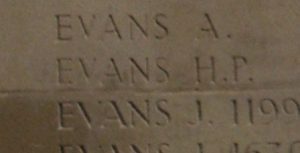
William Henry Head, Private, 235652, Royal Welsh Fusiliers. William was born at North Mimms in 1889, the son of William head and Bessie Head (nee Guy). His father was a gamekeeper and William followed him into the profession. He married Harriett Annie Cale at Forthampton on 2 May 1910 and the couple moved to Rhydycart, Llandefalle soon afterwards, where William had gained a gamekeepers position. The couple’s first two children, Ursula and Marion, were born at Llandefalle and were baptised there in 1912. William enlisted at Brecon into the 3rd Battalion, Monmouthshire Regiment on 11 January 1916. After completing his training, he was drafted to France, embarking at Southampton on 25 July 1917, and after disembarking at Rouen the following day, joined the 4th Infantry Base Depot. William was then transferred to the 4th Battalion, Royal Welsh Fusiliers, before being posted to the 17th Battalion, Royal Welsh Fusiliers on 24 August 1917. The battalion was attached to 115 Brigade, 38th (Welsh) Division and was rebuilding after heavy losses during the opening stages of the Passchendaele offensive the previous weeks. The Division was transferred to the Sailly-sur-la-Lys sector in September and remained in the area over the winter. On 5 December 1917 the 17th RWF moved into the front line in the Houplines Sector, to begin a routine tour in the trenches. William became the only man killed during this short spell in the line, when he was killed on 8 December 1917. The remains of the 28-year-old were carried back behind the lines by his comrades and he was buried in Cite Bonjean Military Cemetery, Armentieres, France.
Thomas Daniel Jones, Private, 55251, Royal Welsh Fusiliers. Thomas was born in 1893, the son of David Jones and Catherine Elizabeth Jones (nee Lawrence), of Tynrheol, Llandefalle. He worked as a gardener prior to the war. Thomas enlisted into the Montgomeryshire Yeomanry at Welshpool in October 1914 and was transferred to the Royal Welsh Fusiliers in November 1916, after being drafted to France with his brother and four other men from Llandefalle. Thomas was posted to the 2nd Battalion, Royal Welsh Fusiliers, which was on the Somme, attached to 19 Brigade, 33rd Division. During the coming weeks the 2nd RWF had received several drafts of reinforcements, and on 8 December the now fully rebuilt battalion moved to new positions at Suzanne, between Bapaume and Péronne. The Division remained in this sector over the coming months, before being transferred to the Arras sector, and reached Henin by 13 April, before the Division took over a section of front line facing the Hindenburg Line. The infantry battalions of the division then began the usual routines of rotating between the front-line, support and reserve trenches and the 2nd RWF took over a position known as Tunnel Trench. On 23 April the 2nd RWF took part in a costly assault on the Hindenburg Line, suffering heavy casualties. Thomas was killed in action during the attack that day. The 23-year-old was originally buried on the battlefield by his comrades, but his grave was later exhumed, and he was re-interred in Heninel-Croisilles Road Cemetery, France.
John Powell Phillips, Private, 33116, East Lancashire Regiment. John was born in 1895, the son of David Phillips and Sarah Jane Phillips (nee Lewis), of Wernos Farm, Llandefalle. He worked for his father on the farm prior to the war. He left home, together with one of his brothers, Tom, soon after the outbreak of war to enlist into the South Wales Borderers, and the young men were given consecutive service numbers, 27489 and 27490. The brothers were drafted to France in the summer of 1916, joining the 2nd Battalion, South Wales Borderers, which had been almost decimated during its assault on Y-Ravine, on the Somme, on 1 July 1916. The Division was then pulled out of the line to rest and rebuild before moving back into the line and taking part in the latter stages of the Somme offensive. The Division wintered on the Somme, taking part in the advance which followed the German withdrawal to the Hindenburg Line. In the Spring of 1917, the Division fought at the Battle of the Scarpe, which was part of the Arras Offensive, seeing heavy fighting around Monchy-le-Preux, and then moved further north to Ypres, initially to hold the line whilst other units had been withdrawn for specialist training, in readiness for the Third Battle of Ypres, which opened on 31 July 1917. The 29th Division went into reserve whilst the first attacks, the Battle of Pilckem Ridge, took place, then on the night of 14-15 August the 2nd SWB moved into the line facing Langemarck, ready to launch another offensive. On the following day the battalion reconnoitred the ground in front of them, and laid white tapes in No Man’s Land, to guide the attacking troops, and at dawn on 16 August 1917 the 2nd SWB launched an attack on Langemarck. The battalion successfully took its two objectives but had suffered 163 casualties. The Division then had another period out of the line to rest and refit before taking part in further fighting near Poelcapelle. Early in October 1917 the Division was relieved from the line at Ypres, and moved south to the Bellacourt area, to prepare to take part in the forthcoming Battle of Cambrai. The Division entrained for Péronne on 17 November, marching to a camp four miles out of the town at Haut Allaines, then by midnight on 18 November had reached Fins. On the following day the Division received its battle stores and detailed orders for the forthcoming battle, marching off via Gouzeaucourt to its assembly positions at Marcoing. The assault began at dawn on 20 November, but the Division suffered terrible casualties whilst attacking Masnières, on the Hindenburg Line. After wintering in the Cambrai sector, in January 1918 the 29th Division moved back to Ypres, taking up positions at Passchendaele Ridge again. To the south, the Germans launched the opening phase of their great offensive along the Somme front on 21 March 1918, then on 9 April launched the second phase along the Lys Valley. The 29th Division was relieved by the 41st Division that day and moved out of the line, before being rushed to positions at Les Haies Basses on the evening of 10 April. On the following morning the Division was hit by the Germans and the 29th Division was forced to withdraw, as they were flanked on the left. John and his brother Tom had survived all of this terrible fighting, however on 11 June 1918 John was posted to the 13th Battalion, East Lancashire Regiment, which had just become attached to 119 Brigade, 40th (Bantam) Division. The division was also in Flanders, and enjoyed a relatively peaceful summer, before joining the great Allied offensive, which had been launched to the south on 21 August 1918. John was killed in action during an assault across the river Lys at Nieppe on 8 September 1918. The 23-year-old has no known grave and is commemorated on the Ploegsteert Memorial, Belgium. His brother Tom and another brother, Walter, who had enlisted after them, both survived the war.
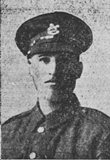
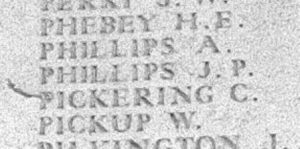
Frank Sydney Powell, Private, 55499, Royal Welsh Fusiliers. Frank was born in 1896, the son of Thomas Powell and Ann Powell (nee Griffiths), of Llandefalle. His father died in 1898, and his mother married John Morgan. Frank was living at Danypark and worked as a farmer prior to enlisting into the Welsh Horse Yeomanry at Newtown on 1 February 1915. He was subsequently transferred to the Montgomeryshire Yeomanry and then to the 4th Battalion, Royal Welsh Fusiliers, being drafted to France on 7 December 1917 to join the 17th Battalion, Royal Welsh Fusiliers. The battalion was attached to 115 Brigade, 38th (Welsh) Division and was holding the Canal Bank sector at Boesinghe. The infantry battalions of the Division then began carrying out the normal pattern of rotation in the trenches, four days in the front, four in support and four in reserve, whilst also working on trench improvement, digging new trenches, and also carrying out regular patrols and trench raids. On 31 July 1917 the Division launched its famous assault on the Pilckem Ridge, capturing Iron Cross and reaching its objective of the Steenbeek. Frank suffered multiple gunshot wounds to his right thigh and back during the attack of 31 July and was evacuated to the 22nd General Hospital at Camiers before returning home to Britain for treatment. Frank was fit enough to return to France by the end of the year and re-joined the 17th RWF at Armentieres, where it was holding the Sailly-sur-la-Lys sector. It remained in the area over the winter before being moved to positions north of Albert, at Bouzincourt Ridge, at the end of March 1918, relieving the battered 2nd and 47th Divisions. It held this sector, again carrying out minor operations and trench raids, over the coming months. By June 1918 Frank had begun suffering from bouts of pleurisy, so was sent for treatment at the 4th London General Hospital, Denmark Hill. Frank was discharged from the army as medically unfit on 20 December 1918 and returned home to Llandefalle. He died at home on 20 March 1919. The 23-year-old was buried in St. Matthew’s Churchyard, Llandefalle. His is the sole war grave there, but he is not currently commemorated as a casualty of war by the CWGC. His case is currently being prepared to send to them for review.
William Price, Private, 56846, Royal Welsh Fusiliers. William was born at Ynyshir in 1896, the son of William Price and Rachel Price. His mother died in 1902, so young William went to live with his uncle and aunt, David and Charlotte Price, at Lower Duffryn Farm, Llandefalle, where he later worked as a shepherd. William enlisted into the Welsh Horse Yeomanry at Newtown in the spring of 1915 and was posted to Ireland with the 3/1st Battalion, Welsh Horse. The battalion returned to England in the summer of 1916 to join the 3rd Line Welsh Division. William was then drafted to France on 16 July 1916 and was posted to the 15th Battalion, Royal Welsh Fusiliers. The battalion was attached to 113 Brigade, 38th (Welsh) Division and had just moved to positions at Hébuterne following its famous assault on Mametz Wood. The division then moved to the Ypres Salient, taking over the Canal Bank sector at Boesinghe. The infantry battalions of the Division then began carrying out the normal pattern of rotation in the trenches, four days in the front, four in support and four in reserve, whilst also working on trench improvement, digging new trenches, and also carrying out regular patrols and trench raids. William was wounded at Ypres on 11 June 1917 and was invalided home, where he was sent to a hospital in Birmingham. Upon his recovery, he was posted back out to France at the end of October 1917, joining the 2nd Battalion, Royal Welsh Fusiliers, which was attached to 19 Brigade, 33rd Division. The division was holding a section of the front line at Passchendaele Ridge, following the closure of the Third Battle of Ypres. The 2nd RWF was in the front line here on 9 January 1918 when William was severely wounded by German artillery fire. He was brought back to a Casualty Clearing Station at Ypres, where he died later that day. The 21-year-old was buried in Ypres Reservoir Cemetery, Belgium.
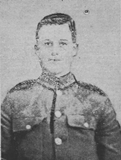
David James Rees, Private, 46138, Welsh Regiment. David was born in 1897, the son of James Rees and Mary Ann Rees (nee Meredith), of Nantydefaid, Llandefalle. His mother died when he was an infant and his father remarried to Caroline Lloyd. James then went to live with his grandmother, Ann Rees, at Llandefalle. James was living with an aunt at Pontypridd when war broke out and enlisted into the army there in 1916. Upon being drafted out to France, David was posted to Ypres to join the 16th Battalion, Welsh Regiment, which was attached to 115 Brigade, 38th (Welsh) Division. The division was holding the Canal Bank sector at Boesinghe, having moved there in September 1916 following heavy losses during its assault on Mametz Wood. The infantry battalions of the Division then began carrying out the normal pattern of rotation in the trenches, four days in the front, four in support and four in reserve, whilst also working on trench improvement, digging new trenches, and also carrying out regular patrols and trench raids. On 23 May 1917 the 16th Welsh was holding positions at Boesinghe when it was subjected to an intense German artillery bombardment. David was one of eight men killed during the bombardment, whilst another eight were wounded. The remains of the 19-year-old were carried back behind the lines and he was buried by his comrades in Ferme Olivier Cemetery, Ieper, Belgium.
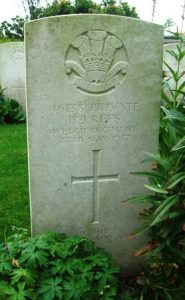
Thomas Ferrar Ricketts, Driver, T1/SR/198, Army Service Corps. Thomas was the son of William Ricketts and Anne Lloyd Ricketts (nee Ferrar), of Trebarried, Llandefalle. He entered Christ College in 1874 and played rugby for the school. Upon leaving school in 1891, Thomas gained a position as a bank clerk for the London and Provincial Bank at Neath, where he continued to play rugby, and was a regular for the Neath First XV. Thomas then went to work for a bank in Natal, South Africa, where he spent eleven years before returning home. During his time there, he served with the Natal Militia during the Zulu uprising of 1906. He then left for Canada but following the outbreak of war returned home and enlisted into the Army Service Corps at Hereford on 12 September 1914. Thomas embarked aboard the SS Trafford at Southampton on 6 November 1914 and disembarked at Le Havre. In March 1915 he became ill and was hospitalised with jaundice, before being sent back to England to recuperate. It was almost eight months before Thomas was deemed as well enough to serve overseas again and on 21 January 1916 he embarked at Devonport aboard HMT Transylvania, bound for Alexandria, then was transferred to Mesopotamia, joining the 39th Field Ambulance. Thomas became ill soon after arriving in Mesopotamia and died of enteric fever at the 3rd General Hospital at Basra on 11 June 1916. The 41-year-old is buried in Basra War Cemetery, Iraq.